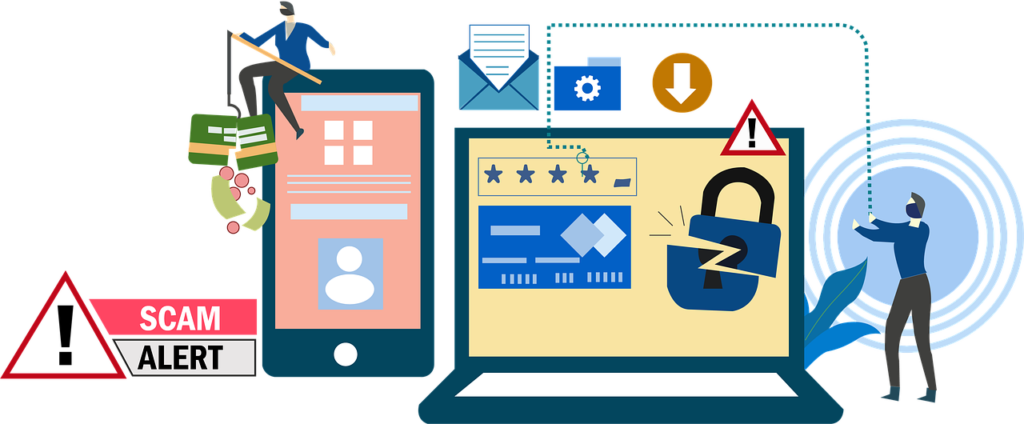Understanding Internet Hazards: Stay Safe Online
Introduction to Internet Hazards
In the contemporary digital landscape, the internet has become an integral component of daily life, facilitating communication, education, and access to information. While this technological advancement has brought numerous benefits, it has also introduced a plethora of risks that can jeopardize users’ safety and privacy. Internet hazards encompass a wide range of online threats, including cyberattacks, identity theft, phishing scams, and exposure to inappropriate content. As individuals increasingly rely on the internet for personal and professional activities, the significance of understanding these potential dangers cannot be overstated.

The reliance on the internet extends beyond mere convenience; it has transformed social interactions, commerce, and even governance. However, as the digital footprint of users expands, so does the vulnerability to various internet hazards. Cybercriminals continuously evolve their techniques to exploit security loopholes, making it essential for individuals to recognize and mitigate risks associated with their online presence. The frequency of headline news related to data breaches and cyberattacks underscores the urgency of remaining vigilant against these internet-related threats.
Awareness of internet hazards is the first step towards creating a safer online environment. Users must equip themselves with knowledge about potential risks and the preventative measures they can implement to protect their information and devices. Whether it is safeguarding personal data from hackers or being cautious of suspicious emails, understanding the nature of these hazards is vital for anyone engaged in online activities. As we delve deeper into the complexities of internet safety, it becomes clear that proactive awareness and education are fundamental in navigating the digital realm securely.
Cybersecurity Threats
In the digital age, understanding various cybersecurity threats is paramount for both individual users and organizations. Cybersecurity threats encompass a wide range of malicious activities that aim to compromise the integrity, confidentiality, or availability of information. Some of the most prominent threats include malware, phishing attacks, and ransomware, each presenting unique challenges and risks.

Malware is a broad category of software designed to disrupt, damage, or gain unauthorized access to computer systems. This can include viruses, worms, and trojan horses. Once malware infiltrates a device, it can lead to severe consequences such as data loss, theft of sensitive information, and degradation of system performance. The impact of malware is not only limited to compromising individual devices; it can also propagate across networks, affecting entire organizations and causing significant financial loss.
Phishing attacks represent another significant cybersecurity concern. In a phishing scenario, attackers impersonate a trustworthy entity to deceive individuals into providing sensitive data, such as login credentials or financial information. These attacks often utilize deceptive emails or websites that resemble legitimate ones. The consequences of falling victim to phishing can be dire, leading to identity theft, unauthorized transactions, or further exploitation by cybercriminals.
Ransomware, on the other hand, is a more aggressive form of cyber attack where malware encrypts the victim’s files, rendering them inaccessible until a ransom is paid to the attacker. This type of cybersecurity threat has risen sharply in recent years, affecting individuals, businesses, and critical infrastructure. The impact is often devastating, resulting in financial losses, operational disruption, and potential delays in recovery.
The rise of these cybersecurity threats highlights the crucial importance of implementing robust cybersecurity measures. Organizations and individuals alike must adopt strategies that include regular software updates, employee training on identifying phishing attempts, and implementing advanced security solutions. Understanding these threats and taking preemptive actions can mitigate risks and safeguard sensitive information.
Privacy Concerns
The digital landscape has transformed the way individuals interact, conduct business, and share information. However, this convenience comes with significant privacy concerns, primarily related to how personal data is collected, stored, and utilized by various online platforms. Every time users engage with websites or applications, they leave behind a trail of personal information, which can include anything from search queries to financial details.
Online platforms often collect data for various reasons, including enhancing user experience, targeting advertisements, or improving services. While some users may willingly share their information, many remain unaware of the extent of data collection practices. Moreover, this data can be stored indefinitely, making it vulnerable to data breaches, unauthorized access, and misuse. These situations pose a serious threat to personal privacy and can lead to identity theft or other forms of exploitation.
To mitigate privacy invasions, individuals must be vigilant and proactive in managing their privacy settings across different platforms. Most online services provide options to control how much personal data is shared and who can access it. Understanding these settings is crucial in ensuring personal information is safeguarded. Additionally, users should be aware of their rights under data protection laws, such as the General Data Protection Regulation (GDPR) in the European Union, which provides guidelines for data privacy and empowers users to control their data.
Furthermore, it is essential for users to practice good cybersecurity hygiene. This includes using strong, unique passwords, enabling two-factor authentication, and being discerning about the platforms they interact with. By taking these steps, individuals can better protect their personal data, maintain their privacy online, and contribute to a more secure internet environment.
Social Media Risks
Social media platforms have become an integral part of modern communication and information-sharing. However, these platforms also present various hazards that users must navigate to ensure their online safety. One prominent risk associated with social media is cyberbullying, where individuals, particularly adolescents, face hostile behavior from their peers online. Statistics show that nearly 37% of young people aged 12 to 17 have been bullied online, which can lead to severe emotional distress and even long-term psychological issues.

Another significant concern is exposure to harmful content. Social media is often theconduit through which inappropriate or extremist content is disseminated. Users, especially minors, can inadvertently come across material that is violent, sexually explicit, or otherwise damaging. Such exposure can shape perceptions and behaviors, potentially leading to irresponsibility and risk-taking in real life. The algorithmic nature of many platforms can compound this issue, as it tends to promote sensational content over safe or educational options.
Oversharing personal information is another perilous trend that arises on social media. Many individuals, in an effort to connect with others, may disclose sensitive information such as their location, contact details, or even financial information. This behavior poses tremendous risks as it not only opens the door to identity theft but can also make users more susceptible to stalking and other forms of predatory behavior. It is advisable to adopt cautious sharing habits; think about the potential repercussions of each post before hitting “share.”
In light of these risks, users should adopt safer social media practices. Configuring privacy settings to limit visibility, being selective about friend requests, and engaging in positive interactions can mitigate some of these hazards. Education about the dangers of online behavior and promoting a culture of respect and responsibility in the digital space can significantly enhance user safety.
Online Scams and Fraud
As the internet continues to evolve, so do the tactics employed by fraudsters aiming to exploit unsuspecting users. Understanding the landscape of online scams is crucial for anyone looking to navigate the digital world securely. Common types of scams include lottery scams, fake charities, and investment fraud. Each of these schemes often shares a common thread: they promise unrealistic returns or benefits that appeal to individuals’ desires for quick financial gain.

Lottery scams typically involve unsolicited emails or messages claiming the recipient has won a large sum of money in a lottery draw, which they did not enter. These scams often require the victim to pay a fee or provide personal information to claim the nonexistent prize. To avoid falling for such traps, it is imperative to remember that legitimate lottery organizations do not request payment upfront to release winnings.
Fake charities represent another prevalent online scam. In the wake of disasters or high-profile events, fraudsters take advantage of people’s goodwill by soliciting donations for fictitious organizations. To protect yourself, always verify the charity’s legitimacy before contributing. Websites like Charity Navigator or GuideStar can help confirm if a charity is registered and trustworthy.
Investment fraud is increasingly sophisticated, with scammers employing tactics such as high-pressure sales techniques and promises of high returns with little risk. Ponzi schemes and pump-and-dump schemes are examples of such fraud. Being cautious with unsolicited investment offers and researching thoroughly before making financial commitments is essential. Always consult with a financial advisor if an investment opportunity appears too good to be true.
In conclusion, awareness is the first line of defense against online scams and fraud. By recognizing the signs of fraudulent activities, individuals can take proactive measures to protect themselves from potential financial loss. Staying informed, skeptical, and vigilant in interactions online will significantly reduce the risk of falling victim to scammers.
Impact on Mental Health
The proliferation of the internet has transformed the way individuals interact, communicate, and consume information. However, this increased connectivity can simultaneously pose significant psychological hazards. One of the foremost concerns is internet addiction, which can lead to a range of detrimental mental health outcomes. Individuals who find themselves unable to control their internet usage may experience heightened feelings of anxiety, depression, and isolation. The compulsive need to stay connected often detracts from face-to-face interactions that are vital for emotional well-being.

Additionally, social comparison is a pervasive issue within online environments. Social media platforms, in particular, can evoke feelings of inadequacy and low self-esteem as users compare their lives to the curated and often idealized images of others. Such comparisons frequently result in negative self-assessment, which can exacerbate mental health disorders and contribute to a distorted self-image. The pressure to maintain an online persona may compound these effects, leading individuals to prioritize their digital presence over their psychological and emotional health.
Moreover, exposure to harmful content, whether it be cyberbullying, graphic imagery, or distressing news, has profound implications for mental health. Continuous engagement with negative or triggering materials can fuel anxiety, desensitization, or even post-traumatic stress reactions. These experiences emphasize the critical need for self-care strategies and healthy online habits. Establishing boundaries around internet use, engaging in digital detoxes, and curating a positive online experience can significantly mitigate these psychological hazards. In fostering a balanced approach to internet usage, individuals may cultivate a healthier relationship with technology and protect their mental health.
Children and Internet Safety
The internet serves as a vast repository of knowledge and entertainment, yet it also presents distinct hazards, especially for children. As young users engage with digital environments, they often encounter inappropriate content which may not be suitable for their age. This content can range from explicit material to disturbing images or videos. Parents must take a proactive role in safeguarding their children’s online experiences by utilizing parental controls and monitoring their activities. Such measures can help filter out harmful content and create a safer exploratory space for younger users.

In addition to inappropriate material, children are at risk of encountering online predators. The anonymity of the internet can enable individuals with harmful intentions to disguise their true identities, thus posing significant risks. Predators may engage with children through social media platforms, chat rooms, or gaming communities, often utilizing manipulation tactics to gain their trust. Education plays a vital role in protecting children from these dangers; equipping them with the ability to identify suspicious behavior is crucial. Parents should openly discuss the importance of never sharing personal information and recognizing red flags in online interactions.
Moreover, fostering a culture of open communication about internet safety is essential. Parents should regularly engage their children in discussions about their online activities, guiding them towards understanding potential hazards and responsible online behavior. Encouraging children to voice any uncomfortable experiences can empower them to seek help when needed. By forming a partnership with their children in navigating the digital landscape, parents can enhance safety and create an environment where children feel secure and supported.
Ultimately, while the internet can offer educational and entertaining resources for children, being aware of the inherent dangers is paramount. Parents must adopt a proactive approach to safeguard their children, ensuring that their online journeys are both safe and enriching.
Legal Implications and Responsibilities
Understanding the legal implications and responsibilities associated with internet usage is crucial for all users. The digital landscape is governed by numerous laws that protect both online content creators and users. One of the primary areas to consider is intellectual property rights. Copyright laws safeguard the work of creators, including music, articles, videos, and software, ensuring they receive appropriate recognition and compensation for their efforts. Users must be aware that unauthorized use of copyrighted materials without permission may lead to legal action, highlighting the need for responsible content sharing practices.
Online harassment is another significant legal concern in the digital realm. Many jurisdictions have enacted laws that protect individuals from harassment and cyberbullying, which can occur through various digital platforms. Victims of online harassment have legal avenues available to them, including reporting incidents to law enforcement or pursuing civil actions. Users must understand that their online behavior can have serious legal consequences and that engaging in harmful actions against others can lead to significant penalties.
Moreover, internet users have a responsibility to ensure their actions do not infringe on the rights of others. This includes respecting others’ privacy, complying with terms of service agreements, and being aware of the potential impact of their online actions. In the rapidly evolving digital environment, laws are continuously being updated to address new challenges that arise, emphasizing the importance of staying informed about one’s rights and responsibilities. Recognizing the legal framework governing internet use not only fosters a safer online experience but also encourages individuals to engage responsibly and ethically within the digital space.
Best Practices for Safe Internet Usage
As the internet becomes increasingly integral to our daily lives, adopting effective practices to enhance online safety is essential. One of the cornerstone strategies for safeguarding oneself is the creation of strong, unique passwords. A strong password should be at least twelve characters long and combine uppercase and lowercase letters, numbers, and symbols. It is advisable to avoid using easily guessable information, such as birthdays or names. Utilizing a password manager can assist in generating and storing complex passwords securely, thereby minimizing the risk of unauthorized access.
Another crucial aspect of safe internet usage is recognizing and avoiding online scams. Cybercriminals are adept at creating deceptive schemes that lure unsuspecting users into revealing sensitive information. Always be cautious of unsolicited emails or messages that ask for personal details, especially those urging immediate action or claiming to be from financial institutions. Instead, verify the sender’s authenticity by contacting the organization directly through official channels. Additionally, staying informed about the latest internet scams can provide an extra layer of protection against these malicious attempts.

Safeguarding personal information is paramount in maintaining one’s privacy online. Users should regularly review privacy settings on social media platforms and limit the amount of personal data shared publicly. It is wise to consider the potential consequences of sharing specific content, as once information is posted online, it can be challenging to retract. Similarly, when using public Wi-Fi networks, it is advisable to employ a virtual private network (VPN) to encrypt internet traffic and protect personal data from potential interception.
Promoting positive online behavior is also key to fostering a secure internet environment. Engaging respectfully with others and reporting harmful or abusive content not only enhances user experience but contributes to a safer online community. In conclusion, by implementing these best practices—strong passwords, scam recognition, personal information protection, and positive interactions—individuals can significantly reduce their vulnerability to internet hazards and navigate the online world more securely.
Sample of the equipments used for Internet usage
- NETGEAR Nighthawk WiFi 6 Router Wireless Speed
- ARRIS (SB8200) – Cable Modem – Fast
- TP-Link AC1200 WiFi Router (Archer A54) – Dual Band Wireless
- Build Your Own VPN Server: A Step by Step Guide
- CableGeeker Ethernet Splitter 1 to 3, Upgrade


